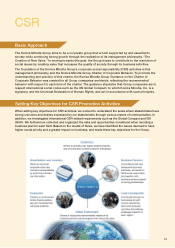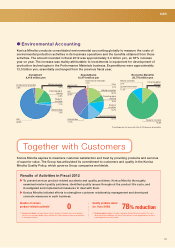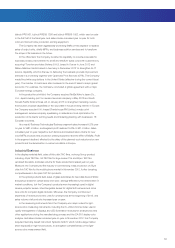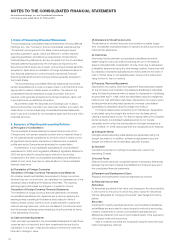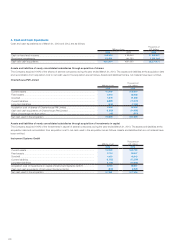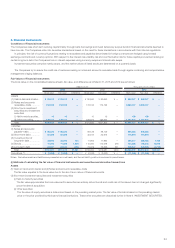Konica Minolta 2013 Annual Report Download - page 25
Download and view the complete annual report
Please find page 25 of the 2013 Konica Minolta annual report below. You can navigate through the pages in the report by either clicking on the pages listed below, or by using the keyword search tool below to find specific information within the annual report.
Legal and Litigation Risk
(12) Intellectual Property
The Group accumulates differentiating technologies and
expertise in the course of product development to ensure the
competitiveness of its businesses, and works to protect these
intellectual property rights. However, legal constraints in certain
regional areas may preclude full protection of intellectual property
and render the Group unable to prevent third parties from
manufacturing and selling products that employ the Group’s
intellectual property.
Furthermore, the Group tries to avoid infringing on the rights
of other companies in developing products. However,
differences of opinion or other factors may result in the
assumption that the Group is infringing on the rights of other
companies, which could render the Group unable to use
important technologies or make the Group responsible for
paying signifi cant monetary compensation.
Furthermore, in the future the Group may be prohibited from
using intellectual property rights it currently licenses from third
parties, or such use may be subject to unreasonable conditions.
(13) Healthcare Systems
The Group’s Healthcare Business is subject to the ongoing
infl uence of the healthcare systems and approval processes of
the countries in which it operates. Factors including healthcare
system reform could result in signifi cant and unanticipated
changes to healthcare administration policy. Inability to respond
quickly to changes in the operating environment in the
Healthcare Business could adversely affect the Group’s results.
(14) Environmental Regulations
The Group is subject to various environmental laws and
regulations governing issues including air pollution, water
pollution, removal of hazardous substances, waste treatment,
product recycling, and soil and groundwater contamination. The
Group may incur expenses and fi nancial liabilities for
environmental obligations associated with past and present
manufacturing activities. In addition, the Group may incur
additional compliance obligations and expenses if environmental
laws and regulations become more rigorous in the future, which
could adversely affect the Group’s results.
(15) Information Leaks
The Group obtains personal and confi dential information on
customers and business partners in the course of operations.
The Group has a system for managing this information and
implements measures including employee training, but
unexpected contingencies could cause this information to leak
externally. This could expose the Group to liability for damages to
injured parties, and could adversely affect the Group’s credibility
and image.
In addition, leakage of the Group’s confi dential information
related to matters including technology, contracts and personnel
could adversely affect the Group’s results.
Disasters and Other Risks
(16) Disasters
The Group has bases worldwide involved in activities including
R&D, procurement, production and sales and operates globally.
Disasters including earthquakes, fi res, typhoons or fl ooding;
pandemics similar to the outbreak of H1N1 infl uenza; or war,
acts of terrorism or computer viruses could damage the Group’s
facilities, temporarily halt operations or delay production and
shipments. Such disasters could also disrupt or restrict use of
essential utilities such as electricity, gas and water; cause supply
shortages of components and raw materials by damaging
suppliers; halt distribution; or disrupt markets. Such
circumstances could reduce net sales below initial plans, incur
signifi cant expenses to restore damaged facilities, or have other
outcomes that could adversely affect the Group’s results.
(17) Impairment of Long-Lived Assets
Effective the fi scal year ended March 31, 2006, the Group
adopted accounting standards for impairment of long-lived
assets including property, plant, equipment and goodwill. The
Group periodically evaluates the carrying value of long-lived
assets on the consolidated balance sheets to determine if their
residual value is recoverable with expected future cash fl ows
from the asset. The Group recognizes impairment when the
asset no longer generates suffi cient cash fl ow because its
operating profi tability has decreased due to competition or other
reasons, which could adversely affect the Group’s results
財務分析
Management’s Discussion and Analysis
24


